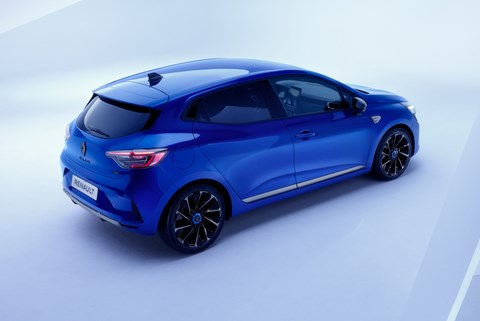► Updated Renault Clio hits the showrooms
► Sharper front-end styling and new Esprit Alpine trim
► Only one powertrain available – and it’s a hybrid
The facelifted Renault Clio is now on sale in the UK with prices starting from £21,295. The French firm’s best-selling supermini has received a front-end makeover, a brand-new Esprit Alpine trim level and a revamped hybrid powertrain, which the company hopes will keep the car’s nose ahead of rivals such as the Toyota Yaris, Peugeot 208 and Volkswagen Polo.
Renault has separated the Clio’s line-up into three specifications called Evolution, Techno and Esprit Alpine. The entry-level Evolution trim features 16-inch alloy wheels, LED headlights, heated door mirrors and rear parking sensors. Inside, buyers get automatic air conditioning, a seven-inch digital gauge cluster and a seven-inch infotainment system with Apple CarPlay and Android Auto.

The mid-range Techno model is priced from £22,695. Upgrades over the base model include 17-inch alloys, front and rear parking sensors, a reversing camera and a shark fin antenna for the roof. The cabin also gets a lift with a customisable ambient lighting system and a wireless smartphone charger.
Renault’s range-topping Esprit Alpine specification builds on this with a set of ‘Alpine’ branded 17-inch alloy wheels, a deeper front splitter and sports seats. There’s more standard equipment, too – you get heated front seats, a heated steering wheel, a 10-inch digital gauge cluster, a 9.3-inch touchscreen and some extra safety equipment, such as adaptive cruise control, blind-spot monitoring and rear cross traffic alert. Prices start from £24,095.
Renault Clio: facelift changes
Renault has a lot riding on the updated Clio, as it’s an immensely successful car for the brand. Since the hatchback was first introduced in 1991, Renault has sold more than 16 million units worldwide, of which 1.1 million found homes in the UK. But there’s a chance Renault could drive buyers away if it fiddles with the formula too much. So, what’s changed for the facelift?
We’ll start with the front end. It’s an evolution of the company’s current design language which we expect will filter down through the rest of the Renault range in the coming years. The arrow-shaped bumper trim and grille shape are like the Austral’s, but Renault has ditched its C-shaped daytime running light signature for new LED chevrons running down the car’s face which, if you squint, look like half a Renault badge on each side of the bumper.
Laurens van den Acker, Renault’s chief design officer, walked us through the Clio styling changes at the car’s launch event. ‘It starts with the eyes,’ he said. ‘And then it needs to be a bit cheeky, a bit sporty, a bit. I think the car in the face has all these elements. You know it has beautiful eyes.’

Renault expended lots of energy on the facelifted Clio’s front end, as it reckons a pretty face will help shift cars out of its showrooms. ‘We’re combining in fact very soft, sensual shapes, but human like with some high-tech details and features,’ van den Acker told us. ‘And you know, if you don’t like the face, you don’t even care about the rest.’
The rest of the car’s styling is largely unchanged. The biggest differences are the (oh-so slightly) reshaped rear bumper and the new clear rear light lenses. Laurens van den Acker explained his thinking on the latter change, stating: ‘We’re putting so much technology in our cars and you can’t see it. And, therefore, we chose for these islands of technology clear lenses, so you can literally see every element [and] how it’s been designed.’
Tell me about this hybrid system
Renault has streamlined the Clio’s UK engine range. The only powertrain you’ll be able to spec in Blighty is a 1.6-litre four-cylinder self-charging hybrid unit with 143bhp and 151lb ft of torque. It’s mated to an unusual clutchless six-speed automatic gearbox – and Renault says the unit has enough grunt for a 0–62mph time of 9.3 seconds.
More importantly, Renault says the Clio E-Tech hybrid will be ruthlessly efficient. Under official WLTP testing, it can return between 65.7–67.3mpg with CO2 emissions as low as 96g/km. When we drove the car, we managed to average around 60mpg – so Renault’s claims are at least honest if not entirely accurate.

It’s clever, too. Renault says the petrol engine and electric motor can combine in 14 different ways to improve efficiency. It can run on electric power alone for 80% of the time in cities which the firm says cuts fuel consumption by up to 40% when compared to a conventional petrol engine.